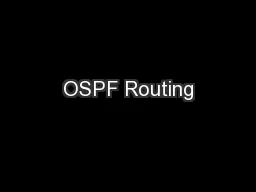

With CrossAddress Family MPLS Traffic Engineering Tunnels draftsmirnovospfxafte00 RFC 3630 specified MPLS TE traffic engineering capabilities for OSPFv2 RFC 5329 specified MPLS TE capabilities for OSPFv3 ID: 402211
Download Presentation The PPT/PDF document "OSPF Routing" is the property of its rightful owner. Permission is granted to download and print the materials on this web site for personal, non-commercial use only, and to display it on your personal computer provided you do not modify the materials and that you retain all copyright notices contained in the materials. By downloading content from our website, you accept the terms of this agreement.
Slide1
OSPF Routing
With Cross-Address Family
MPLS Traffic Engineering Tunnels
draft-smirnov-ospf-xaf-te-00Slide2
RFC 3630 specified MPLS TE traffic engineering capabilities for OSPFv2
RFC 5329 specified MPLS TE capabilities for OSPFv3If network is dual stack IPv4/IPv6 and runs both OSPFv2 and OSPFv3 then it is possible to enable MPLS TE in both:OSPFv2 and OSPFv3 TE are “ships in the night”TE infrastructure is duplicated: two MPLS TE tunnels along each path – one is signalled by OSPFv2 and used for IPv4 traffic and one is signalled by OSPFv3 and used for IPv6 trafficDuplication of TE may be undesirable:Resource and scalability implicationsOperational implications (operator may want to concentrate on service level delivered by TE tunnel and ignore details of which IP version is used by clients)
IntroductionSlide3
Introduction (cont.)
OSPFv2, RFC 3630
IPv4 TE signalling
IPv4 routing
OSPFv3, RFC 5329
IPv6 TE signalling
IPv6 routing
Modern dual-stack IPv4/IPv6
network running OSPF & TESlide4
Want to decouple TE tunnel signalling from the routing
decision – cross-address family MPLS TE tunnelsFor example, OSPFv2 is used to signal MPLS TE tunnels and to route IPv4 traffic; OSPFv3 routes IPv6 traffic and uses those MPLS TE tunnels for IPv6 routingDifficulty: to use TE shortcuts SPF must identify Rtr LSA of tunnel tail-end router (i.e. where the tunnel terminates)This knowledge comes for free when the same protocol instance is used to both propagate signalling information and to make routing decisionsBut when a protocol instance wants to make routing decisions for TE tunnels signalled by another protocol instance, identifying Rtr
LSA of the tail-end router is problematic
Problem definitionSlide5
OSPFv2 used to signal TE tunnel
What is known about the tunnel:Tunnel destination IPv4 address (the one advertised by OSPFv2 in Router Address TLV). Meaningless in context of IPv6/OSPFv3OSPFv2 Router ID of tunnel’s tail-end router. Has meaning in OSPFv2 LSDBThere is no reliable way for OSPFv3 to determine where the tunnel terminates
Problem definition (cont.)
?
OSPFv2 database
OSPFv3 databaseSlide6
Simple (for developers) solution – require that OSPFv2 and OSPFv3 instances have the same Router ID
In this case Rtr ID of router which advertised in OSPFv2 TE LSA with Router Address TLV can be used to lookup Rtr LSA in OSPFv3 LSDBVery simple to implement – not-so-simple for operators:OSPFv2 and OSPFv3 are independent protocols, ensuring Rtr ID consistency is manualTunnel head-end has no built-in protocol means to verify that tail-end conforms to this “gentlemen’s agreement”
Problems with Router ID assignment are rare but DO routinely happen
What will happen if tail-end router does not use the same Router ID for OSPFv2 and OSPFv3 instances:
Best case: OSPFv3 can’t find
Rtr
LSA with the same ID in its LSDB -> can’t use TE tunnels to this tail-end router
Worst case:
Rtr
ID exists but is assigned to another router -> incorrect routing decision -> suboptimal routing and risk of routing loops
Simple (but problematic) solutionSlide7
RFC 5786: “
Advertising a Router's Local Addresses in OSPF Traffic Engineering (TE) Extensions”Defines TE (sub-)TLVs to advertise IP addresses local to the router but other than Router Address TLVApplication: to advertise additional addresses to terminate TE tunnels
Necessary digression – RFC 5786
Loopback 1
Loopback 2
TE 1
TE 2Slide8
RFC 5786 – sub-TLV format
0 1 2 3
0 1 2 3 4 5 6 7 8 9 0 1 2 3 4 5 6 7 8 9 0 1 2 3 4 5 6 7 8 9 0 1
+-+-+-+-+-+-+-+-+-+-+-+-+-+-+-+-+-+-+-+-+-+-+-+-+-+-+-+-+-+-+-+-+
| 1 | Length |
+-+-+-+-+-+-+-+-+-+-+-+-+-+-+-+-+-+-+-+-+-+-+-+-+-+-+-+-+-+-+-+-+
| Prefix Len 1 | IPv4 Prefix 1 |
+-+-+-+-+-+-+-+-+-+-+-+-+-+-+-+-+-+-+-+-+-+-+-+-+-+-+-+-+-+-+-+-+
|Prefix 1 cont. | :
+-+-+-+-+-+-+-+-+ ~
: . :
~ . +-+-+-+-+-+-+-+-+ : . | Prefix Len n |
+-+-+-+-+-+-+-+-+-+-+-+-+-+-+-+-+-+-+-+-+-+-+-+-+-+-+-+-+-+-+-+-+ | IPv4 Prefix n | +-+-+-+-+-+-+-+-+-+-+-+-+-+-+-+-+-+-+-+-+-+-+-+-+-+-+-+-+-+-+-+-+
0 1 2 3 0 1 2 3 4 5 6 7 8 9 0 1 2 3 4 5 6 7 8 9 0 1 2 3 4 5 6 7 8 9 0 1
+-+-+-+-+-+-+-+-+-+-+-+-+-+-+-+-+-+-+-+-+-+-+-+-+-+-+-+-+-+-+-+-+ | 2 | Length | +-+-+-+-+-+-+-+-+-+-+-+-+-+-+-+-+-+-+-+-+-+-+-+-+-+-+-+-+-+-+-+-+ | Prefix Len 1 | Prefix 1 Opt. | IPv6 Prefix 1 |
+-+-+-+-+-+-+-+-+-+-+-+-+-+-+-+-+-+-+-+-+-+-+-+-+-+-+-+-+-+-+-+-+ | IPv6 Prefix 1 cont. : : . ~ ~ . : .
: +-+-+-+-+-++-+-+-+-+-++-+-+-+-+-+ : | Prefix Len n | Prefix n Opt. | +-+-+-+-+-+-+-+-+-+-+-+-+-+-+-+-+-+-+-+-+-+-+-+-+-+-+-+-+-+-+-+-+ | IPv6 Prefix n :
| : +-+-+-+-+-+-+-+-+-+-+-+-+-+-+-+-+-+-+-+-+-+-+-+-+-+-+-+-+-+-+-+-- Slide9
Use Node Local Address sub-TLV defined by RFC 5786 to help non-signalling OSPF instance identify tunnel tail-end routers
Tunnel termination IP address is known but it is from address-family ‘foreign’ to the instanceIn non-signalling OSPF instance Node Local Address sub-TLVs advertise cross-address family IP address(es) where TE tunnels can be terminatedNot all IP addresses are advertised; typically it is just one address – the one which signalling OSPF instance advertises in TE Router Address TLVNon-signalling OSPF instance then takes XAF tunnel termination address and looks up its OWN LSDB which router advertised TE LSA with matching Node Local Address
Proposed solutionSlide10
Proposed solution (example)
OSPFv2 database
Each router advertises:
RFC 3630 TE signalling
(optional) additional IPv4 RFC 5786
R1: TE tunnel:
RID 192.168.1.1
Dest
addr
1.1.1.1
Router Address TLV 1.1.1.1
R1
?
OSPFv3 database
Ra
Rb
Each router advertises:
(optional) RFC 5329 TE signalling
(optional) additional IPv6 RFC 5786
XAF IPv4 Node Local Address sub-TLV
Ra:
Rb
:
RID 10.1.1.1 RID 10.1.1.2
Router Address TLV AAA::1 RA TLV AAA::2
XAF Local
Addr
2.2.2.2 XAF LA 1.1.1.1
Where does the TE tunnel terminate? On
Rb
, obviouslySlide11
Discussion